
Student of Anthropology at the University of Queensland, Brisbane
e-mail: merlin@webexpress.net.au
UQ Catalogue #1311 抟 AY 281 Problems in Museum Anthropology
A comparative research study of the stylistic differences and functional similarities between the wooden battle and dance shields of East and West New Britain.
The aim of this research report is to draw attention to the stylistic differences and functional similarities between the wooden battle and dance shields of East and West New Britain. Two artifacts from the University of Queensland Anthropology Museum have been chosen to represent both regions. The cultural areas will be defined both geographically and linguistically, and the artifacts, themselves described according to resources accessed via the UQ Anthropology Museum records as well as throughout Brisbane libraries. Due to the lack of available information specifically relating to the artifacts chosen their 'stylistic type' has been researched on a broader scale.
Cultural, Linguistic and Geographical Locations
As previously mentioned the focus artifacts are two battle and dance shields from New Britain, the first of which (catalogue # 1311 - Appendix One) is known to have originated from an unknown location on the South East Coast of New Britain (Museum records). Due to the insufficiency of available information certain deductions have been made regarding the cultural, linguistic and geographical origin of this artifact. The first such deduction is that the area would fall within the area between Montague Harbour and the city of Lau (fig 1). The linguistic groups that occupy that area are the Mangseng, Mamusi and the Uvol speaking people (fig 2). Catalogue # 25247 (Appendix Four) originated in Kandrian, Passamanua, West New Britain (fig 1) where the dominant linguistic group is that of the Kaulong speaking people (fig 2).
Figure One - Geographical Locations
Blue indicates: Catalogue # 1311, South East Coast New Britain
Red indicates: Catalogue # 25247, Kandrian, Passamanua, West New Britain

Figure Two - Language distribution
Blue indicates: Catalogue # 1311, South East Coast New Britain
Red indicates: Catalogue # 25247, Kandrian, Passamanua, West New Britain
Physical Description
Catalogue # 1311 can be described as a oval shaped shield approximately 60 inches, 152.5 cm in length. The body is decorated with two conventionalized human masks and tough reddish-yellow intertwined cane, criss-cross binding, scientifically applied to all points liable to split (Museum Records). These are characteristic of many other shields within the region of New Britain (Appendix 2&3). For measurements see Appendix One. The shield is made of a dark brown wood into which the human masks and other decorations are carved and paint fills the depressions. The rear of the shield has an approximately 3 inches, 6.75 cm wide and 6inches, 15 cm long handle.
Catalogue # 25247 can be described as a three section rectangular shaped shield decorated with concentric circles which are made similarly to catalogue # 1311. This shield is also bound with cane strips, and of approximately the same height as #1311, 132.3 cm tall (For more measurements see Appendix Two). Similar stylistic features can be seen appearing within the region (Appendix 5&6).
Component Materials
As previously mentioned, Catalogue #1311 is made of a dark brown wood criss-crossed at points of stress with striped cane/grass and edged with sewn grass or sinnet (Museum Records).
Catalogue # 25247 offers more information although it can be seen as somewhat unreliable as the wood used is identified as being balsa. The discrepancy here lies in the indigenousness of balsa, balsa is not indigenous to New Guinea or New Britain. It is therefore possible that the information supplied by the donor is incorrect or that the wood was imported/traded. The three sections of the shield are secured with cane and the design was carved then filled with an indigenous paint, consisting of lime, betel nut juice (betel, lime, peppercorn, saliva), clay and charcoal (Museum Records).
Included in this section is information obtained from the University of Queensland Anthropology Museum records, not previously addressed.
U.Q. Catalogue #1311
Notes on Use
It is interesting to note the solidity of the shield, it appears to be made for a practical purpose if only to survive a lifetime of ceremonial use. It is said to have maximum strength and lightness, the thick center part protects the hand and blows are absorbed with the top and bottom extremities. These shields are also said to have been carried aslant the body in dance as well as in battle.
History - From Whom
This artifact was collected by Sir Raphael Cilento, although a date is not documented for either collection or obtainment in the Museum records (see 4.2).
U.Q. Catalogue #25247
Notes on Use
The donor states that these kinds of shields are used by men in fights with a spear and also carried in dances and ceremonies.
History - From Whom, Date Obtained, Date Collected, Age, Price Paid
This artifact was collected by Peter Van Fleet in 1973 for a sum of $3.00 and obtained by the University of Queensland Anthropology Museum in 1983. It is said to have been 3-4 years old when collected from Kandrian, making it 29-30 years old today. Peter Van Fleet was a patrol officer in New Guinea who latter studied with the Anthropology Department of the University of Queensland.
Ethnographic Information
Such ethnographic information will include any information not previously addressed as well as information obtained through sources excluding the University of Queensland Anthropology Museum records.
Sources
Various sources of information were discovered within libraries throughout Brisbane as well as various internet sites and discussions with anthropologists working in the area of New Guinea, those which were used have been listed in the section titled references cited. It is important to note that some bibliographical information was obtained where the books were unavailable, these are included in the section titled other references.
As mentioned in 3.1b above, Catalogue # 1311 was collected by Sir Raphael Cilento, although a date is not documented for either collection or obtination in the Museum records. Upon further research and discovery of Sir Raphael's biography, certain deductions were made so as to ascertain the approximate date of collection. Sir Raphael served as a medical officer in the New Guinea region between the years of 1924 and 1928, which would make the aforementioned artifact at least 70-75 years old, although the artifact could well have been made many years prior to collection (Fisher 1994).
When this research was first undertaken it rapidly became apparent that it was not an easy task to acquire accurate information. For example, Krieger Herbert in 1943 made a misleading and confronting statement that "defensive shields are apparently unknown" (Herbert 1943:68) when talking of New Britain. At first it was assumed that this author may not have been privy to culturally sensitive materials. "In many societies, art is almost wholly reserved for ceremonial occasions, being created or displayed only then, and hidden or even destroyed afterwards. This seems to be true, for example, of much of the art of New Ireland and New Britain [etc]" (Chowning 1973:38). Perhaps Herbert was not on the Island when dances or ceremonies were being performed, although Goodale speaks of many ceremonial dances taking place regularly in an area just north of Kandrian (Goodale 1996). Further reading disbanded the theory of cultural sensitivity as Herbert speaks of the 'dukduk' (a secret society of New Britain) in much depth. This source leaves researchers of New Britain shields perplexed. Ann Chowning addresses the futility of making generalizations about New Britain and New Guinea as they are "not unified culturally or stylistically" (Chowning 1973:38). This becomes apparent when evaluating the artifacts provided, and leads the researcher to the assumption that the area Kriger Herbert was reporting on may not have had any such shields.
The indigenous naming of shields in Kandrian, West New Britain is well exemplified by Goodale as she tells of them being called 'planks' (Goodale 1996:110), although this name connotes a mundanity of reference and usage, quite the opposite is true for the context in which these shields are made and used. This context is intertwined with social status, gift exchange and the religious/sacred/ceremonial realm. The ownership and successful use of shields in New Britain is said to increase a persons status as "only men who had previously fought and killed with spears and 'plank' were allowed to go to elections" (Goodale 1996:127). Shields are used for many occasions in New Britain, 'Singsings' are quite popular, this is a ceremony where pigs are sacrificed, the 'singsing' is not limited to one specific occasion and is regularly performed. "Outsiders come armed with spears and shields and use these as percussion together with drums as they sing throughout the twelve hour night. In the morning the pigs are killed, butchered and 'given' to the outsiders as part of a pork trade exchange partnership - a highly political relationship" (Goodale 1996:72-73). This relationship touches on the exchange relations between the indigenous peoples of New Britain.
"In Kaulong (the language area of Kandrian - See Fig 1&2) the owner has a choice of giving or not giving. By giving to another and by the others acceptance, there is established an exchange relationship, because now the receiver must reciprocate gifts at some latter date, which itself must be reciprocated and so on . . . exchange relationships establish and validate an individuals kin relationships" (Goodale 1996:72).
In terms of manufacture the religious realm can also be seen demonstrated and participated in. Catalogue #25247 is painted with a mixture of lime, betle nut juice, clay and charcoal. It is the use of betel nut juice which holds relevance to us here as although there is no specific information which outlines the religious use of betel in New Britain, there is no doubt that betel is chewed at least during the painting of the shields. Betel nut juice consists of betel, lime peppercorn and saliva and is therefore assumed to be collated within the mouth. Betel is known to be used in other cultures/culture groups for a religious/ceremonial purpose (Keesing 1945:76). The fact that the shields are decorated with totemic images also indicates the religious realm. It is important to note that although the shield designs vary greatly in content they are basically composed of the same stylistic variables (Appendices 5&6). Cranstone identifies some similarities such as the appearance of conventionalized anthropomorphic patterning (Cranstone 1961:44) this can be seen within the appendixed photos.
When making a comparison between the dance and battle shields of East and West New Britain many similarities can be seen in terms of functionality. Both of the shield types (including the focus artifacts) are used for warfare as well as for ceremonial dancing. Other similarities occur when addressing the socio-cultural contexts in which they are used, both types can be seen as representations of social status, intertwined with reciprocal gift giving kin relations. Differences appear in the style of the shields themselves. It appears that the oval shields are most prolific within the Eastern areas of New Britain, namely the area between Montague Harbour and the city of Lao (Fig 1) and are consistently decorated with a pattern of concentric circles. The shields from Western New Britain, namely Kandrian (Fig 1) appear to be totemic in nature, comprising of conventionalized anthropomorphic masks, and constructed in an oval shape with characteristic criss-crossing of cane/grass at strategic 'stress' points. Both the similarities and differences are best illustrated when viewing the attached appendices.
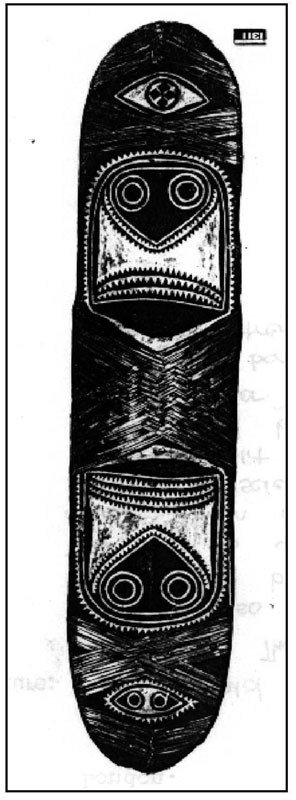

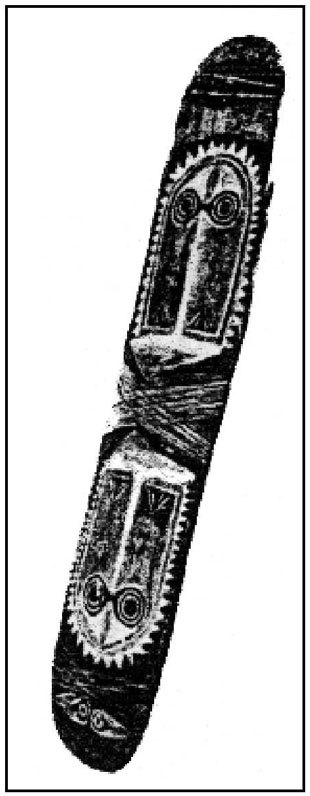
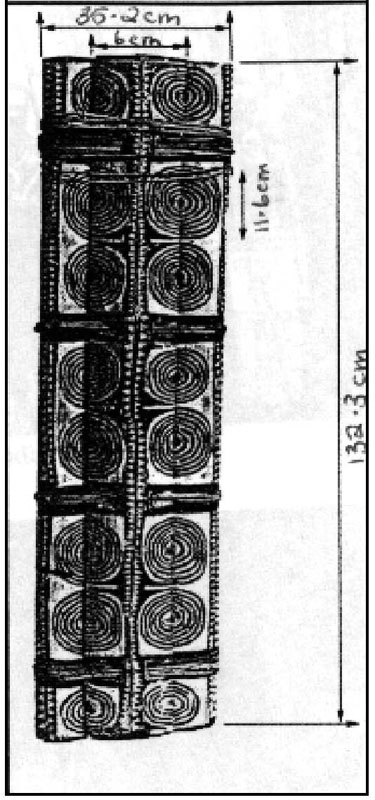
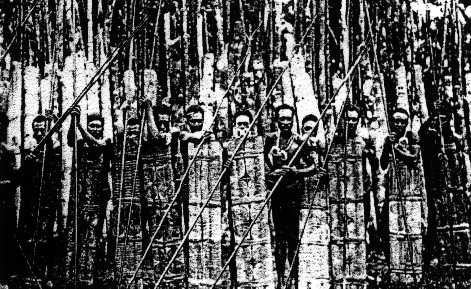
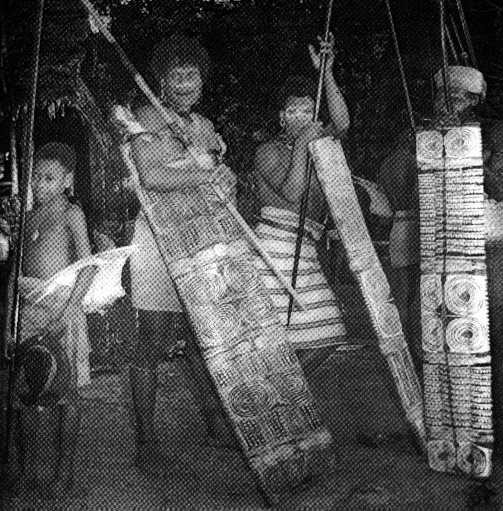
Chowning, A 1973 "An Introduction to the Peoples and Cultures of Melanesia" an Addison-Wesley Module in Anthropology #38 Reading Massachusetts: Addison-Wesley Publishing Company Inc.
Cranstone, B A L 1961 "Melanesia: A Short Ethnography" London: Trustees of the British Museum.
Fisher, F.G 1994 "Raphael Cilento: A Biography" Queensland: University of Queensland Press.
Goodale, J with Ann Chowning 1996 "The Two-Party Line: Conversations in the Field" New York: Rowman and Littlefield Publishers Inc.
Herbert, K 1943 "Island Peoples of the Western Pacific; Micronesia and Melanesia" Washington: Smithsonian Institution.
Keesing , F M 1945 "Native Peoples of the Pacific World" New York: The Macmillan Company.
Other References
Berg P 1992 "Singsing Tumbuan (mask dance)" Boroko, Papua New Guinea: Asples Productions in co-operation with the P.N.G. National Museum and Art Gallery.
Chewings, H 1900 "Mongst Tropical Islanders or Notes and Observations made during a visit in 1899 to New Guinea, New Britain and the Solomon Islands" Adelaide: The Macmillan Company.
Chowning, A 1969 "The Austronesian Languages of New Britain" Canberra: Pacific Linguistics.
Counts, David and Dorothy (electronic mail) 1/8/99 <countsd@lesamoa.net>